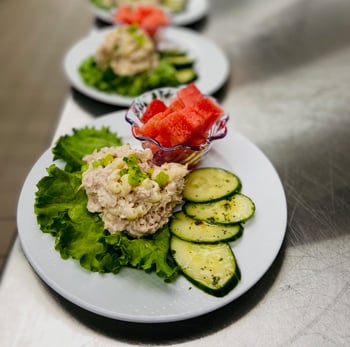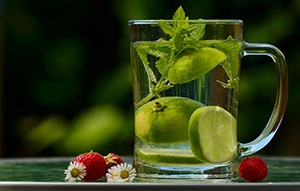5 Healthy Foods Older Adults Should Have In Their Diets
Ashley Graven, RD, LD, CPT | Nov 2, 2015
Eating a well-rounded, balanced, nutritious diet is often more difficult than we think. Between the Internet and today’s marketing of processed foods, there is misleading information and food temptation everywhere. Putting all of this aside, there are many healthy food items to add into your daily routine. Not only will these foods be higher in quality nutrition, but they will also increase your quality of life. Here are a few simple, nutritious, healthy foods for older adults to incorporate into their diets. Adding vibrancy to your life, one healthy food at a time.
1. Colorful Plates Unite!
We all know we are supposed to eat vegetables on a daily basis – however, many of us don’t actually consume the appropriate amount of vegetables to prevent disease, much less consume any at all. We need 9-11 servings of fruits and vegetables per day. The problem is, people generally prefer to grab a juicy fruit rather than steamed broccoli. This being said, we should aim to eat three vegetables to one fruit (3:1 ratio of vegetables to fruit).
The antioxidants, vitamins, and minerals are important nutrients to function optimally as we age. The analogy or visual I often use is to consume as many vegetables as the size of your head each day. Start by setting goals. Maybe it’s adding in more of a variety of colors of vegetables or adding in two vegetable snacks per day. Whatever you do, start small and watch large health improvements along the way!
2. Fats – Are They “Bad”?
 The fat in our food supply has been given a bad name over the years, but I’m here to assure you: not all fat are bad. Healthy fats are important for brain function and long-term health, especially as we age. Some examples of healthy fats include nuts, seeds, avocados, olive oil, coconut oil, flax seed, and natural nut butters. The biggest advice I can give is to not fear fat – eating fat will not make you fat, as long as it is the right kind.
The fat in our food supply has been given a bad name over the years, but I’m here to assure you: not all fat are bad. Healthy fats are important for brain function and long-term health, especially as we age. Some examples of healthy fats include nuts, seeds, avocados, olive oil, coconut oil, flax seed, and natural nut butters. The biggest advice I can give is to not fear fat – eating fat will not make you fat, as long as it is the right kind.
Add in healthy fats throughout your diet on a daily basis. Be aware of your portion, however, as fats are more caloric (contain more calories per gram) than carbohydrates or proteins. When choosing dairy, consume full-fat products – when manufacturers take the fat out of a product, they usually replace it with sugar, sodium, or other additives to make up for the consistency and make it palatable. Besides, you will also feel more full after meal if you allow yourself to consume various high-quality healthy fats.
3. How Much Protein do I Need?
Protein is needed to help make our muscles grow and stay strong. As we age, losing some strength is common, but we can prevent some weakness through fueling our body with adequate amounts of protein. When it comes to protein sources like meat, poultry, and fish, quality is one of the most important things to consider. Always go for grass-fed, antibiotic free, lean, wild-caught protein sources when able. This will ensure the animals were in safe handling and will also give you more omega-3 fatty acids and other healthful ingredients. If you choose to not consume meat or other protein sources, such as dairy, do not worry – there are other plant-based protein options to choose from as well. Soy products, beans, legumes, lentils, nuts, and seeds are all great sources of protein aside from animal sources.
The amount of recommended protein varies per person due to the variety in body weight; however aiming for 1.2-1.5 grams of protein per kilogram of body weight is a good start for aging and older adults. Consume protein with every meal to ensure you are preserving your lean body mass and providing your muscles with the food it needs.
 4. H2O – An Important Nutrient
4. H2O – An Important Nutrient
Our bodies are primarily water, therefore adequate hydration is essential to our health. As we age, it can be more difficult to consume enough water throughout the day. Water hydrates the skin and helps optimal mental function. Start by tracking how much water you consume on a daily basis to get a baseline of your hydration. How much do you need? Aim for half your body weight in ounces of water each day and see how much better you feel focusing, how much clearer your skin looks, and how you have an extra little spring to your step from your cells being hydrated properly!
5. When in Doubt – Eat Whole Foods!
Since eating a “healthy diet” can be difficult and somewhat confusing, the biggest focus should be eating whole foods. We were meant to eat foods that are naturally found, rather than processed and man-made. If you can look at a food and you think that your ancestors would have eaten it, then it is probably a good choice! If it can grow from the ground or from a plant or tree, it is considered a “whole food”. Start looking through your cupboards or noticing what you are being served for your meals and asking yourself if what you are eating is a whole food – if so, you are eating much better than roughly 95% of Americans. At the end of the day, trying your best is what really matters.
Finding a balance between perfect nutrition and ‘living a little’ is one of the best things you can do for your physical health and mentality. Challenge yourself to make small changes first. Following these five simple steps will help your quality of life, your health, and your vitality - I know your whole body with thank you for it!

Ashley Graven, RD, LD, CPT
Life Time Fitness
Registered & Licensed Dietitian/Weight Loss Coach
Certified Personal Trainer

